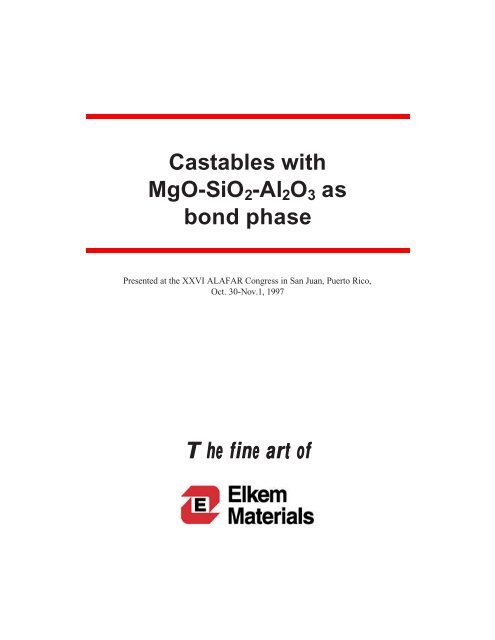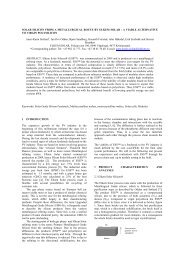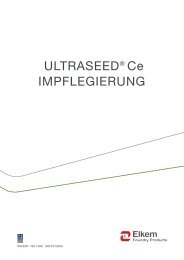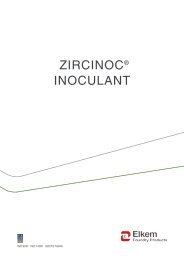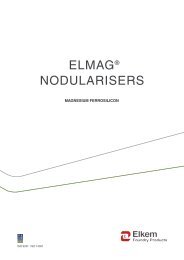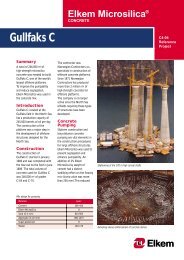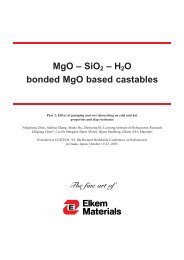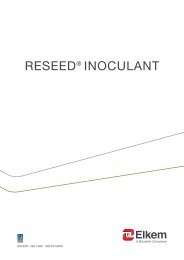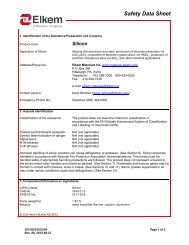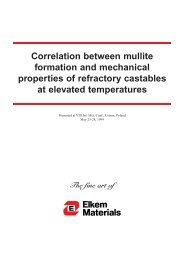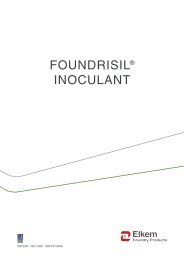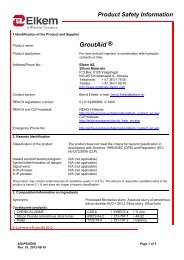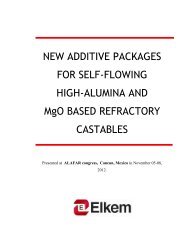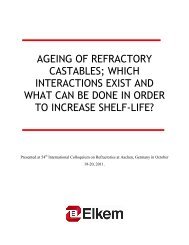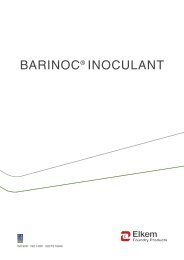CASTABLES WITH MgO-SiO2-Al2O3 AS BOND PHASE - Elkem
CASTABLES WITH MgO-SiO2-Al2O3 AS BOND PHASE - Elkem
CASTABLES WITH MgO-SiO2-Al2O3 AS BOND PHASE - Elkem
Create successful ePaper yourself
Turn your PDF publications into a flip-book with our unique Google optimized e-Paper software.
Castables with<strong>MgO</strong>-SiO 2 -Al 2 O 3 asbond phasePresented at the XXVI ALAFAR Congress in San Juan, Puerto Rico,Oct. 30-Nov.1, 1997The fine art of
<strong>C<strong>AS</strong>TABLES</strong> <strong>WITH</strong> <strong>MgO</strong>-SiO 2 -Al 2 O 3 <strong>AS</strong> <strong>BOND</strong> PH<strong>AS</strong>EB. Myhre, B. Sandberg and Aa. M. Hundere,<strong>Elkem</strong> Refractories Kristiansand, Norway.ABSTRACT:Cement-free castables based on the hydration products of magnesia and microsilicawere made with additions of alumina and selected aggregates so that the compositionswere within the alkemade triangle periclase-spinel-forsterite. The bond-phase wascomposed in a manner so that it would after firing consist mainly of forsterite and spinelto which aggregates of either periclase, spinel or olivine was added. Using the rightdeflocculant, this castable was self-flowing at low water additions. Cold properties likeflow and cold strength is presented together with hot-M.O.R. data obtained on prefiredsamples.INTRODUCTION:Refractory castables containing spinel has the recent years become common, and a partof many refractory producers portfolio. These castables have normally a cement bondand contain either pre-formed spinel, or magnesia and alumina that is supposed to formspinel upon firing. The latter alternative is cheaper, but here one have to consider thesignificant volume expansion that accompanies the formation of spinel from the oxides. Ifthis is unaccounted for, a disruptive expansion causing cracking may be seen when theproduct is fired.In most cases, refractory castables contain microsilica. This is to reduce the water forcasting and hence the porosity of the fired product. For corundum-spinel castables, ithas been shown 1 that even tiny amounts of silica drastically reduces the hot strength ofthe refractory, even though according to the phase diagram, a mullite bondedcorundum-spinel castable should be viable. A thorough examination of the phasediagram shows however that there are so many sub-solidus reactions occurring duringheat up that strong refractories based on corundum, spinel and mullite is most unlikely,at least on a short term 2 . The equillibria in question shifts over relatively narrowtemperature ranges (1400-1500°C) so in practice, such a refractory would probably
not be a strong body at steel-making temperatures. Nevertheless, even for spinelcastables, microsilica is sometimes being used, although usually in small amounts (1-2%?). It seems as if the microsilica is added to give softening to compensate for thedisruptive expansion of the spinel formation. Since microsilica for these reasons normallyis not used in significant amounts, relatively much water has to be added for casting.Even with submicron alumina as superfines, water additions are higher than if microsilicawas utilized to a full extent. Experiments on particle packing has shown that there seemsto exist a minimum water addition for superfine alumina corresponding to 15-16%porosity while less than 10% porosity may be obtained with microsilica 3 .Based on these observations, it was found that castables within the compatibility trianglepericlase-spinel-forsterite would have a better chance of gaining good hot strength thanthose within the triangle corundum-spinel-mullite. To minimize the content of impurities,it was decided to make castables with a bond system based on the coagulation productsbetween <strong>MgO</strong>-SiO 2 and H 2 O. This bond system has been described elsewhere 2,4,5 andhas to the Authors knowledge also been used by some refractory producers. Its maindisadvantages seems to be control of set time and a tendency of explosive spalling. Thusthe scope for the present investigation was to make castables within the compatibilitytriangle periclase-spinel-forsterite using the <strong>MgO</strong>-SiO 2 bond. The castable should alsopreferentially be self flowing at low water additions.C<strong>AS</strong>TABLE COMPOSITION:As mentioned above, the castables should be based on the hydration product of <strong>MgO</strong>-SiO 2 with a net composition such that it would be placed within the alkemade trianglepericlase-forsterite-spinel. Among raw materials for such castables are spinel andolivine, the latter a cheap natural source that transform mainly into forsterite upon firing.Fine alumina was added to compensate for an expected shrinkage caused by theformation of forsterite from magnesite and microsilica. This should give spinel that shouldcompensate for some of the shrinkage. The bond phase was common for all castablecompositions being based on milled magnesite, microsilica and calcined alumina. Thisshould after firing give a phase assemblage of approximately equal amounts of periclaseand forsterite with some spinel. This is of course provided equilibrium is established. Tothis bond phase, either olivine, magnesite or spinel was added to make up essentiallyforsterite, periclase or spinel castables all with some of all three components. Figure 1shows the phase diagram magnesia-alumina-silica with the approximate composition ofthe bond phase and the three castables indicated. The bond phase is the composition inthe center of the four.
FPBSFigure 1:The system <strong>MgO</strong>-Al 2 O 3 -SiO 2 after Muan and Osborn. 6 F indicates theforsterite castable, P the periclase and S, the spinel castable. B is thecommon bond phase.The castables were composed to match a particle size distribution with a q-value of0.25 according to the model given by Andreassen 7 . A such particle size distribution hasbeen found to give castables with semi self flowing properties at very low wateradditions (around 13 vol%) provided use of the right superfines and a deflocculatedsystem. It is important to use microsilica that is easily dispersed to get optimum flow. Itwas found difficult to get proper dispersion since the traditional deflocculantss used inrefractory castables did not give good flow at the low water addition that was aimed for(13 vol%). It was finally found that 0.25% Vanisperse CB, a deflocculant originallydesigned for carbon black (hence CB) gave the best flow. This deflocculant is a byproductfrom vanilla-production (Borregaard, Norway) and is also the only to us knownadditive that is able to retard set of the <strong>MgO</strong>-SiO 2 bonded castables. Choosing the rightmilled grade <strong>MgO</strong> is also important to get the right flow. It seems important to mill adead burned quality to keep the reactivity down. A proper particle size distribution is ofcourse also important.
Table 1 shows the castable composition of the present investigation. The magnesite wasa deadburned magnesite from Billiton (Nedmag99), microsilica was from <strong>Elkem</strong>Refractories, spinel from ALCOA, calcined alumina from British ALCAN, Olivine fromA/S Olivin and Vanisperse CB from Borregaard (latter two are Norwegian companies).Table 1:Castable compositionCastable components: Spinel Forsterite MagnesiteWeight %:Magnesite: -100 micron 35 35 35Microsilica 983U 8 8 8Calcined alumina: BACO MA95D2 5 5 5Spinel AR78: 1-3mm 28Spinel AR78: 0.5-1mm 12Spinel AR78: 0-0.5mm 12Olivine 1-5mm 20Olivine AFS20 20Olivine AFS30 12Magnesite: 1-4mm 28Magnesite: 0.5-1mm 19Magnesite:
and the resultant spreading taken as the vibra flow value. I.e. both tests were performedon the same castable sample.Cold strength:Strength was measured on samples of 40x40x160mm (<strong>AS</strong>TM C348) cured for 24hours before drying at 110°C. Samples were then fired at 600 and 1000°C for 12hours. Subsequently, strength was tested on the dried sample (110°C) and on the firedsamples. The cold strength testing was performed according to <strong>AS</strong>TM C348 (flexuralstrength) and <strong>AS</strong>TM C109 (compressive strength).Hot M.O.R.:Hot M.O.R. testing was performed on samples of 25x25x150mm in accordance withPRE/R18. The samples were pre fired for 24 hours at test temperature and allowed tocool before being loaded into the test machine. The heating rate was 300°C/h for boththe pre firing and the testing, and the samples were allowed to equilibrate at testtemperature for at least 30 minutes prior to testing.Permanent Linear Change:Permanent linear change (PLC) was measured on 40x40x160 mm prisms. As thereference state, wet prisms directly after demoulding was chosen as opposed to the110°C dried prisms generally used. This was done because it has been realized that asignificant amount of the PLC occurs during the drying of a castable. Experiments onvarious types of castables have shown that the PLC during drying amounts to -0.2 to -0.5%, a significant shrinkage normally not accounted for.RESULTS AND DISCUSSION:Flow:Table 2 shows the flow values for the three castable compositions obtained by the useof 13 volume% (4.5-4.6wt%) water. Generally, a free flow value of above 40-50 isenough for pumping, while higher values are necessary to make the castable self flowing.With some vibration however, a castable with a free flow of 50 is easily installed foralmost any application. We see that both the forsterite composition and the magnesitecomposition give good free flow while the spinel composition is adequate, but somewhatlower. All vibra flow values are excellent.Table 2: Flow of the magnesite bonded castables.Castable: Spinel Forsterite MagnesiteFree flow [%] 60 80 80
Vibra flow [%] 128 140 128Cold strength:The cold crushing strength (compressive strength) after drying and firing at 600 and1000°C is shown in Figure 2. It is seen that the <strong>MgO</strong>-SiO 2 -Al 2 O 3 bond is capable ofgiving strengths well above 100 MPa, a strength that is maintained up to 600°C. Asevere drop in strength at 1000°C has earlier been seen for castables with the <strong>MgO</strong>-SiO 2 bond 5 , here with fine alumina in the bondphase, this drop seems to be somewhatless severe. The actual reason for this lowering in CCS around 1000°C has not beenunderstood, but crystallization of <strong>MgO</strong>-SiO 2 species may play a role.160Cold crushing strength [MPa]14012010080604020ForsteriteSpinelMagnesite00 200 400 600 800 1000 1200 1400 1600Temperature [C]Figure 2:Cold crushing strength of the <strong>MgO</strong>-SiO 2 -Al 2 O 3 based castables as afunction of firing temperature.The cold M.O.R of the castables is shown in Figure 3. The drop in crushing strengtharound 1000°C is not present here, except for the magnesia castable. The results of themagnesia castables are in good correlation with earlier results, although the values hereare somewhat lower. The present bond system is however slightly modified containingalumina.
20181614ForsteriteSpinelMagnesiteM.O.R. [MPa]1210864200 200 400 600 800 1000 1200 1400 1600Temperature [C]Figure 3:Cold Modulus of Rupture of the <strong>MgO</strong>-SiO 2 -Al 2 O 3 based castables as afunction of firing temperature.Hot strength:In real life, it is the hot M.O.R. that matters, not the cold. Generally the hot M.O.R.values are similar, or slightly above the cold equivalents at temperatures up toapproximately 1000°C. It is therefore generally accepted to use cold M.O.R. values asan approximation up to 1000°C instead of the often more elaborate hot-testing. Figure4 shows the hot M.O.R. values of the castables at 1200, 1300, 1400 and 1500°C. Allsamples had 24hours prefiring at test temperature and the values are the mean of 2parallels, the single results were normally within plusminus 1 MPa of the mean. Theincrease in strength when the temperature is increased from 1200 to 1300°C for themagnesite castable, coincides with the increase for the forsterite castable, while thespinel castable decrease in strength. As all three castables have a common bond phase,i.e. the fraction below 100 micron, it is somewhat surprising to find these quite significantdifferences already at 1300°C. Obviously there is something about the spinel that isincompatible with the <strong>MgO</strong>-SiO 2 bond. It has earlier been demonstrated 1 that even a0.2% silica addition to alumina-spinel castables could drastically reduce hot strength at1500°C. That was however for alumina-rich castables and should therefore notnecessarily apply to the magnesite rich compositions of the present investigation. At1300°C the forsterite and the magnesite castable have similar strengths with the spinelcastable being somewhat lower. At 1400°C however, the picture is changed, with themagnesite at a low level together with the spinel castable and the forsterite castable
maintaining its strength. At 1500°C the spinel castable and the magnesite castable havebecome so soft that the strength is barely measured, around 2-3MPa, while theforsterite castable still maintains its strength. As a matter of fact, the lowering in strengthat 1500°C for the forsterite castable is so small that it could well be caused by commonvariation of the hot M.O.R. testing results. At 1500°C the spinel and magnesite samplesshowed soft, plastic fracture, the forsterite sample had brittle and transgranular fracture.201816ForsteriteSpinelMagnesiteHot M.O.R. [MPa]141210864201200 1250 1300 1350 1400 1450 1500Temperature [C]Figure 4:Hot Modulus of Rupture of prefired (24h) samples as a function oftemperature.The low strength combined with visual observation of the samples indicate that there issome sort of incompatibility between the bond phase and the spinel aggregate. Soseems also to be the case with the magnesite composition. With olivine however, thecastable is significantly strengthened. The reason may be connected to thetransformation of olivine to forsterite upon firing. A simultaneous formation of forsteriteboth from olivine and in the bond phase assures a good bond between the aggregatesand the bond phase. Furthermore as olivine is somewhat deficient in magnesia to giveforsterite, reaction between the aggregates and the magnesia of the bond phase is likelyto result in better bonding. With spinel or periclase, a reaction between the bond phaseand aggregates is unlikely, resulting in lower strength because of poor bonding.Permanent Linear Change:Figure 5 shows the permanent linear change of the three castables as a function oftemperature. Here, the reference state is “prisms as demoulded”, i.e. still “wet”, hence
the negative values at 110°C. The shrinkage during drying is between 0.2 and 0.3%, avalue not uncommon for castables. Between 110 and 1000°C the dimensions are closeto constant, while at 1500°C, differences are appearing. The forsterite castable shows asignificant expansion, this may be connected to mineralogical changes of the olivine withformation of forsterite and iron containing species. The spinel castable also shows anexpansion, the origin may be formation of spinel. The periclase castable however shrinkssignificantly. This excessive shrinkage may be caused by sintering aided by liquidformation, an assumption strengthened by the observed softness at 1500°C hot M.O.R.testing. The spinel sample is also soft at 1500°C. Excessive shrinkage seems howevernot to occur.0.4Permanent linear change [%]0.20.0-0.2-0.4-0.6-0.8-1.0-1.2ForsteriteSpinelMagnesite0 200 400 600 800 1000 1200 1400 1600Temperature [C]Figure 5:Permanent Linear Change of the <strong>MgO</strong>-SiO 2 -Al 2 O 3 based castables asa function of firing temperature.CONCLUSION:It is possible to make self flowing castables based on the <strong>MgO</strong>-SiO 2 bond with wateradditions as low as 13 volume%. This is comparable to what has been found in aluminabased ultralow and low cement systems. Good flow is however dependent on thechoice of both right quality of milled magnesia and the proper deflocculant at the rightamount. With the present bond system containing some alumina, castable compositionswith olivine, spinel and magnesia were prepared. These castable had good strength upto 1000°C where a drop in compressive strength was observed. The hot M.O.R.
esults showed that the olivine based castable had superior strength at 1400 and1500°C, possibly caused by enhanced bonding between bond phase and aggregatesdue to mineralogical transformations.REFERENCES:1234567G. W. Kriechbaum et al. : “ The Matrix Advantage System, a new approach to lowmoisture LC selfleveling alumina and alumina spinel castables.” in proc. XXXIX Int.Feuerfest-Koll, Aachen, Sept 24-25 1996. p. 211-218.B. Sandberg, B. Myhre and J. L Holm: " Castables in the system <strong>MgO</strong>-<strong>Al2O3</strong>-<strong>SiO2</strong>" inProc. UNITECR´95, The Techn. Ass. of Refr., Japan. Kyoto, Japan Nov. 19-22 1995,vol. II, p. 173-80B. Myhre and Aase Hundere: "On the influence of superfines in high alumina castables".In proc. XXXIX Int. Feuerfest-Koll, Aachen, Sept 24-25 1996. p. 184-188B. Sandberg and T. Mosberg: "Use of Microsilica in Binder Systems for Ultra-lowCement Castables and Basic, "Cement-free" Castables", Ceramic Transactions vol. 4:Advances in Refractories Technology, ed. by Robert E. Fisher, The Am. Ceram. Soc. Inc.,Westerwille, Ohio, 1989 p.245-258B. Myhre:" Cement-free castables in the system <strong>MgO</strong>-<strong>SiO2</strong>; The effect of bond-phasemodifiers on strength", <strong>Elkem</strong> a/s Refractories report. (Available upon request).A. Muan and E.F. Osborn :"Phase Equilibrium Diagrams of Oxide Systems", Plate 3,publ. Am. Cer. Soc. and the Edward Orton, Jr., Ceram. Found. 1960B. Myhre and K. Sunde: "Alumina based castables with very low contents of hydrauliccompound. Part I: The effect of binder and particle-size distribution on flow and set.", inProc. UNITECR´95, Kyoto, Japan, Nov. 19-22 1995


